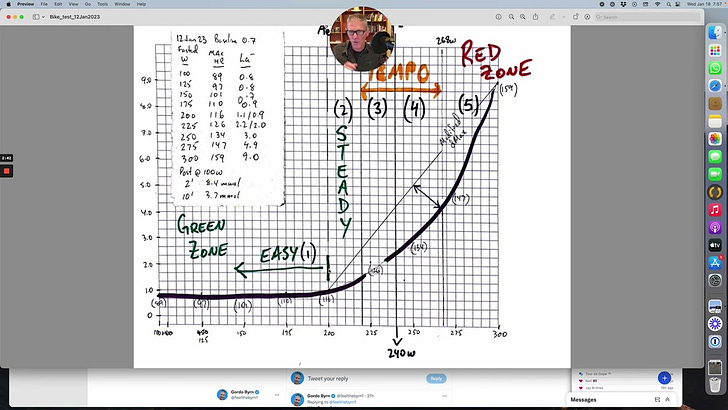Last week, we covered Capacity & Volume.
We considered how to apply Coach Bu’s advice into our own training plans.
Keep your program simple and persist.
As Olav Aleksander tells the Bergen Boys:
Complexity Creates Consequences
Related, we have three topics today:
Concentration - amount per
Volumetric - total amount
Kinetics - rate of change
These topics repeat in Bu’s interviews.
Concentration & Relative Metrics
Bu is careful to point out each time he discusses a concentration or relative metric.
Lactate - mmol/L
VO2max - ml/kg/min
Watts per Kilo
Hematocrit
Muscle Fiber Ratios
Beware: Concentrations Can Change
Invest time to understand how your target metric changes over time.
Hydration status
Blood volume status
Fatigue status
Training status
Bu has spent a career learning about his preferred metrics.
My takeaways:
Some metrics are too noisy to be useful. Choose with caution1.
Some metrics are highly trainable2. These can point towards useful training adaptations.
As an athlete, what to do?
Keep your plan simple and repeat it.
Slowly expand your areas of interest, say lactate testing. Invest time to understand your individual profile.
Patiently build your understanding.
Understand the limitations of your metrics.
Avoid constant protocol tweaks.
Whatever protocol you choose, give it time to work.
Change Slowly.
Volumetric & Absolute Metrics
Too often, we obsess over “small metrics” (Bu’s term).
Capacity & Volume, matter.
Much of the other stuff, doesn’t.
Bu is most interested in metrics impacting athletic capacity. Look to his research.
Topics that came up in the conversations.
Muscle biopsy results are suspect.
They are site dependent.
They ignore muscle volume.
They are unable to see the athlete adapting over time.
This is like his advice on genetics from Part One.
No athlete can see their ultimate physiology before undertaking their Endurance Journey.
Relative VO2max results, also suspect.
First because the data is often garbage - unfortunate but true.
Second because the metric is too far from Specific Capacity.
Third because the velocity:duration curve is more important.
And finally, because our physiology highly trainable.
Again, what to do?
Stop distracting yourself with small metrics.
Focus on metrics that help you tolerate volume - sleep, for example.
Build capacity.
Attention is expensive.
Kinetics: the rate of change in a physical system
These discussions were exciting.
When something is changing, pay attention.
Relative Perceived Exertion
Heart Rate
Breathing
Core Body Temperature
Sweat Rate
This is a high-performance topic that you can apply daily.
For every workout, you will have a normal range.
For your specific training, you will have a normal range.
For external conditions, you will have a normal range.
Before you blow yourself up with a pacing mistake, your kinetics will “flash red.”
The Norwegians have a deep understanding of the kinetics they can tolerate. For example, they mentioned heat and heart rate kinetics on their podcast with Rich Roll.
Where should you start?
Breathing Kinetics
Specifically, your breath markers. Pay attention to how breathing changes over time.
Heart Rate Kinetics
Start by noticing decoupling.
What makes it arrive quicker?
What’s required to recouple?
What’s required to stay coupled?
Taken together, your breathing and heart rate kinetics indicate your stress status.
Stable breathing and heart rate => stable stress
Rising breathing and heart rate => rising stress
Rapidly rising breathing and heart rate => impending doom, perhaps
Kinetics are an essential aspect of endurance pacing.
Showing You Sustainable Effort Over Time
Enabling You to Optimize Your Velocity
The way it feels, early, is not the way it is. Bu notes:
The RPE Scale does not account for TIME.
Speaking from experience, a well-paced Ironman feels like a sustained training day…
…until the last 90 minutes when it becomes the hardest thing you’ve ever done.
Same thing for a marathon.
Kinetics offer insight into sustainable pace.
The Capacity to Endure
Take this piece as a whole.
What are we seeking to achieve?
Streamline where we focus.
Pay attention to what matters.
Prune distractions and complexity.
Learn sustainable pace.
Then, put all the energy we didn’t spend (on our distractions) towards the final third of our competitive event.
Too many athletes are tapped out before they reach the start line.
Complexity Creates Consequences3
Back To Table of Contents
I know coaches who feel this way about power, heart rate and lactate. They still get results.
Dr. Inigo San Millán brought this up, indirectly, with reference to muscle cell plasticity. We each have a relative position “today” which is different from where we could be “tomorrow.”
A quote from my elite days, “Every thought slows my recovery.”



